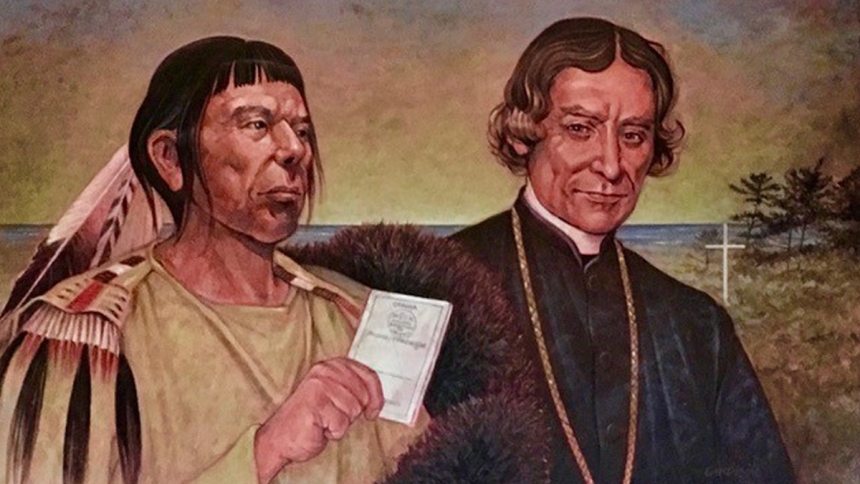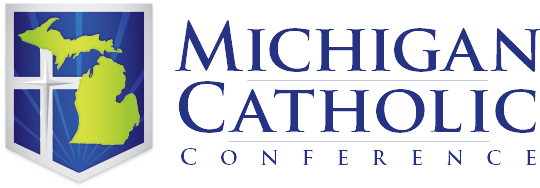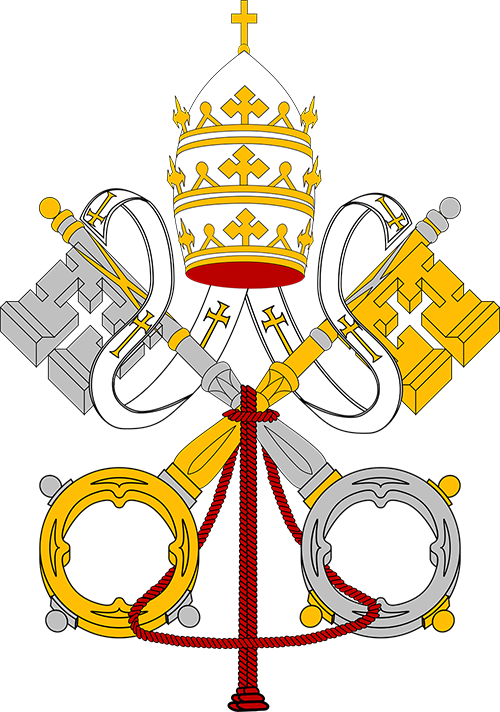
Jesuit missionaries circumnavigated the Great Lakes region centuries ago in celebration of sharing the zeal of Christ in the Eucharist. It is the fortitude of these heroic ministers that defines the narrative of the rich Catholic history throughout the L’Arbre Croche community. In particular, four European clerics have shaped the narrative on the shores of Northern Michigan because of their ministerial zeal to evangelize. The charitable works of mercy of these “black robes” spoke beyond language barriers to feed and sustain both body and soul of the Native Americans they served. This blending of trust and faith improved the dimensions of healthy and spiritual life, creating lasting Christian communities for future generations.
Father Gabriel Richard
The entire Michigan territory benefitted under the pastoral care of French cleric Father Gabriel Richard who ministered throughout the territory and invested directly in human infrastructure of “good works and learning.”
Notable Accomplishments:
- He brought the first printing press to Michigan.
- He founded the first newspaper.
- He co-founded the University of Michigan and acted as vice president, professor and trustee.
- He was the only priest to serve the Federal Government as a Congressman from the immense Michigan Territory before its entrance to the Union in 1837.
- He was committed to serving the underserved and being the voice for the people of the region.
Venerable Bishop Frederic Baraga
Excerpts from a diary belonging to Father Samuel Mazzuchelli from around 1831 illuminate the heroic fortitude of Slovenian native then-Father Frederic Baraga throughout the L’Arbre Croche territory. Shortly after he arrived in America, then-Father Baraga built a church in Manistique and established his first mission in present-day Harbor Springs. His passion for spreading the word was influential in the classroom setting, too, as he served at St. Peter School, later renamed Holy Childhood of Jesus School, in Harbor Springs.
Then-Father Baraga rebuilt a log church on the site of the Jesuit’s “college” naming it Saint Anthony Church Cira. 1832-1833. Missionaries following Baraga embellished and added to the little bluff church. Holy Cross Church replaced the little bluff church when it burned in the fire of 1918. The refurbished church stands today with pews from first-cut timber, dating back to Bishop Baraga. The altar came from old St. Anne’s on Mackinac Island and was sledded over on the ice.
Notable Accomplishments:
- Shortly after wintering over in Cincinnati, then-Father Baraga arrived at his first mission following Fr. DeJean in present day Harbor Springs.
- He established missions in present-day Petoskey, Good Hart, the Leelanau Peninsula — now St. Kateri Tekakwitha Parish — and throughout the Upper Peninsula.
- He learned, spoke and wrote in both Odawa (Ottawa) and Chippewa writing the first prayer books in these languages so that children could learn more quickly and easily. Bishop Baraga evangelized and catechized thousands of Native Americans.
- He was as the “Snowshoe Priest.” He traveled thousands of miles of rugged, cold and desolate woods in Northern Michigan, sacrificing himself for the salvation of others.
Baraga sacrificed himself for the salvation of others. On numerous instances, he battled the harsh elements to evangelize and catechize to ensure the natives had a spot at the Eucharistic Banquet of Christ and the glorified hope of eternal salvation. “Bishop Baraga gave up everything to come to America and live amongst the natives so he could teach them the faith,” says Lenora McKeen who serves as executive director of the Bishop Baraga Association. “He could have had a much easier life as his family was considered nobility.”
In a letter to his sister, Amalia, dated March 10, 1832, he writes, “It is unspeakably joyful and consoling to me to be here … I cannot sufficiently thank God for my coming here where so much good can be done.”
In his diary Bishop Baraga noted: “All I can do is to pray to God to send soon several laborers to this abandoned part of his vineyard, so that many immortal souls, redeemed by his precious blood, may not parish.”
Bishop Baraga’s passionate words embody the love of a committed shepherd who, like other faith-filled ministers, brought Christ to the faithful of Northern Michigan. Baraga’s heroic missionary zeal is paralleled by the visionary spirit of Prussian Native Father John Weikamp who likewise offered his ministerial fortitude within the territory of today’s L’Arbre Croche community.
Bishop Baraga was named the first bishop for the Upper Peninsula of Michigan in 1853 until his death in 1868. He was declared Venerable in 2012; his cause of canonization continues today.
Father John Weikamp
Ordained in Rome by Pope Pius IX in June 1849, Father Weikamp would later enrich the Cross Village territory with the construction of a convent that would, at its climax, house 46 brothers and sisters.
Notable Accomplishments:
- He built The Benevolent Charitable and Religious Society of Saint Francis Convent and completed it in January 1856.
- He founded The Benevolent Charitable and Religious Society of Saint Francis, with lay brothers and sisters who lived in the convent.
- Through the convent, he contributed to the town’s growth with its famed farming fields, using state-of-the-art techniques, attracting boatloads of tourists. The brothers and sisters at the convent produced products for all their personal needs, using both the mill, grist mill and blacksmith shop. They also produced clothing from sheep wool, shoes, etc.
- He established both the convent and village parochial school taught by third order brothers.
Father Francis Pierz
Father Pierz’s trip to America was a kaleidoscope of mishaps. He traveled by wagon and coach with no hope of rest day or night. Drivers got lost, turned over the coach and ran it down a steep embankment.
His early challenges, however, did not define his successful ministerial efforts.
Notable Achievements:
- He traveled to every village twice to inoculate a multitude of Native Americans from the smallpox epidemic, saving hundreds.
- He founded village station schools along L’Arbre Croche in 1844.
- He established a saw and flour mill in Cross Village, allowing for better housing and the building of more substantial boats to fish commercially.
Historical Richness
For over 300 years, the territorial community of the L’Arbre Croche region has been a beacon of proclaiming the principles of Christ to the faithful of Northern Michigan.
Thanks to Father Marquette’s missionary zeal, Jesuit missionaries were actively proclaiming Christian principles throughout L’Arbre Croche during the eighteenth century, with Cross Village likely the oldest continually inhabited village in Michigan. The seeds of Catholicism were deeply planted throughout the region and the Liturgy of the Eucharist was being celebrated as early as 1742.






